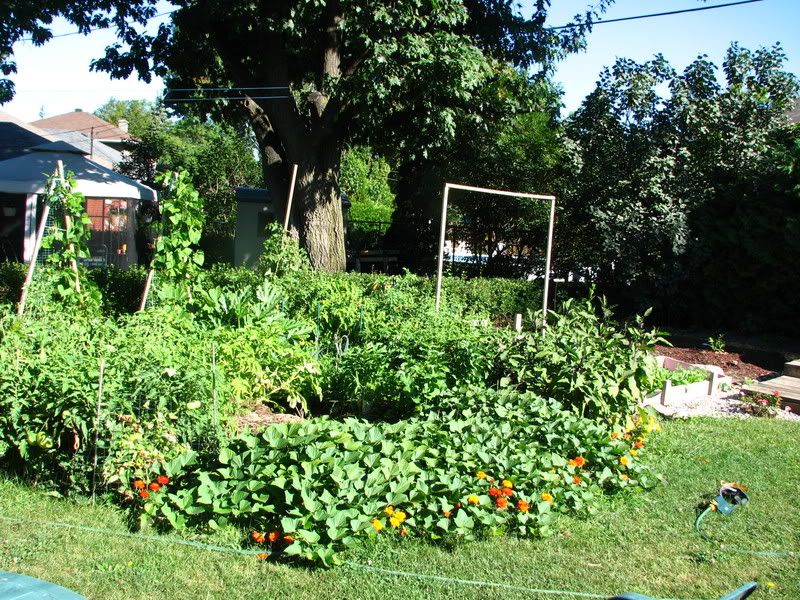Just thought of some other great ideas for season extension that I forgot in my previous post.

Garden 2007, I think. See the tree in the photograph - read the third paragraph to find out its important.
Site of garden
If you haven't already comitted to a place for your veggie patch then look for a place that gets at least 6 hours of sun (normally on the south / souteast corner). If you have a wind break on the north and west side then you'll create a sunny, sheltered microclimate. Evergreens make great wind breaks but some productive bushes work too. Another thing you could do is to add a stone or brick wall on the north side (this will be south facing as you put your back against it and face south) of your garden to catch heat. If you are lucky enough to have a brick walled house with a south facing wall then you could build a lean-to greenhouse against it and I will be very envious of you.
Other important aspects of citing your garden are that the soil is close to neutral pH and is well drained and fertile. A well drained area where the grass grows most lush often will work well, assuming that it has adequate sun. Of course if you have only poorly drained, partially shaded ground or concrete, edibles can still be grown. I'll write a post soon.
Raised beds
These will heat up faster in the spring. Also if you slant your beds so they create a slight south facing hill, you'll also increase the warmth and growing season.
Plant near a polite** tree
Okay, let me be contraversial for a moment. I have a garden that is on the north-eastern side of my yard with a giant oak tree due north, partially overhanging so you know that oak roots traverse the whole of the veggie patch. Produce grows with heady abandon in this garden nonetheless and the tree helps. Hey? Didn't they teach you that you shouldn't place a vegetable patch near a tree. Well, take heart urban gardeners who have no choose but to grow their food with loaming shadows of nearby trees, it can be done. My tree casts little shadow because it's on the north side and it isn't one of the greediest rooted trees, but best of all, its root system warms up the soil early in the season and keeps mild frosts at bay late in the season. Seriously, I have seen ground frost everywhere but around the root system of this oak. I guess it acts a little bit like a heating cable once the sap gets running in the spring and before the tree is dormant in the fall. Crazy cool eh?
It also drops an abundant mulch of oak leaves for my pathes. I have yet to notice problems with soil acidity though I do add add compost and manure so maybe it evens out. And if that wasn't enough, according to Roots Demystified, the tree can even help water the garden - but you'll have to read that book to find out the details. It's available at the Ottawa Library.
** Bishop's Homegrown made a great point and is one of my favourite reasons for comments - to improve and expand the web of information. Polite tree means one that does not exude growth restricting hormones such as black walnut and is not a greedy feeder so that very little has the luck to grow beneath it. If grass, perennials or other plants grow well 6 feet out from the trunk (right beneath the tree will be pretty shaded) then it'll probably be fine to plant a veggie patch nearby. Remeber, that if it is to the north, it won't cast as much shade.
***
paper on wind breaks

1 comment:
I've had gardens under trees before that do very well, never experimented under oaks however, I do though compost the oak leaves that I gather every year, it seems as long as the leaves have a chance to break down thoroughly there is no real danger of damage to your plants from the tanins, of course a healthy dose of lime is probably warranted from time to time to keep the PH in check as well.
The only caution I'll throw out to those reading is to not plant underneath of black walnut trees as the black walnut produces a growth toxin that keeps other plants from thriving at their bases, the toxin is produced by the whole of the tree including roots, bark, leafs, and fruit (nuts).
We use a lot of raised beds on the farm and last year I went ahead and broke down and bought a disc or ridge hiller/tiller for the tractor, it definitely saves on the back aches of making a hill manually. We set it out to the widest setting which is exactly the width of my manure spreader, I spread my compost using the manure spreader, go back hill it up, spread again, and then hill it up a second time, makes a terrific bed. On the south facing hill of the farm, using this method I can get many crops in up to two weeks ahead of other areas!
Great article friend, keep them coming!
Post a Comment